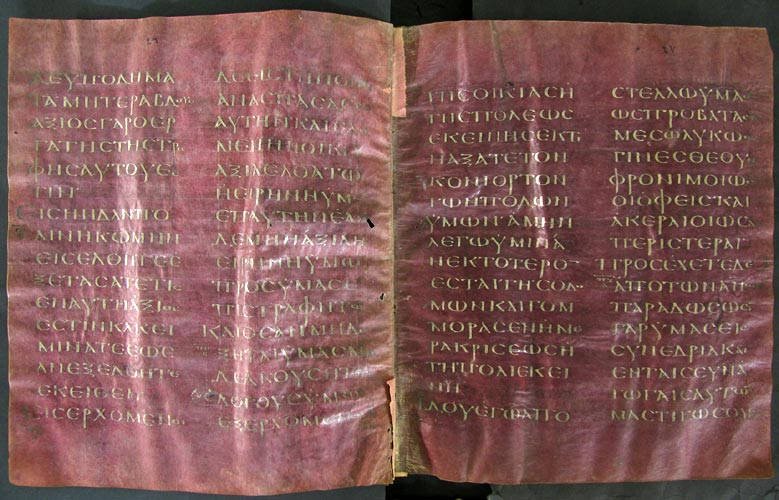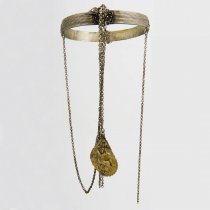Purple Gospel
Purple codex folio.
6th century.
ΒΧΜ 862
At the BCM is preserved a leaf from a 6th-century purple codex. The book is made up of parchment sheets (specially treated animal skin), as was customary at that time, containing the four Gospels (Tetraevangelion). The present folio is inscribed with a passage from the Gospel according to Matthew (14: 22–31). The text occupies two columns, each one consisting of 16 lines, written in Greek majuscule letters using silver ink, which has been tarnished today due to oxidation. In contrast, the heading, but also the words Ιησούς (Jesus) and Κύριος (Lord) are written in gold (every time they appear in the text).
The characterization “purple” derives from the technique employed, according to which parchment sheets were immersed into a purple dye bath. Purple extracted from seashells was the most expensive and beautiful dye since antiquity. During the Byzantine period, the production of purple dye became a state monopoly and its use was associated with the imperial environment. This provides a clear indication that the purple codex from which the Byzantine Museum folio comes constituted a very significant and valuable object. As a result of the damage it suffered over a period of 15 centuries since its creation, the folio’ purple colour has now considerably faded, whereas the letters from its back (verso) “shine through” to the front side (recto).
The numbers 81 and 82, inscribed on the folio, refer to the pagination of the codex to which the leaf originally belonged. It was the famous purple codex N (Codex Petropolitanus Purpureus), the largest part of which is kept in the National (formerly known as Imperial) Library of Russia at Saint Petersburg. Based on palaeographic criteria, the codex dates back to the 6th c. and was created most likely in an imperial scriptorium of Constantinople. It contains the Greek text of the four Gospels, written in uppercase letters, using silver or gold ink on parchment impregnated with purple dye. It has been estimated that the codex originally consisted of 462 leaves. Today, 231 of them are preserved: 182 in Russia, 33 in the Monastery of Saint John the Theologian on Patmos Island, 1 in Athens and 1 in Thessaloniki, whereas several others are found in the Vatican, London, Vienna, New York and Italy.
The fragment kept at the Byzantine and Christian Museum comes from the village Sarmousakli, near Caesarea in Cappadocia. The circumstances under which the folio was detached from the codex, thus turning into a loose leaf, remain unknown. It was transferred to Greece, alongside other “refugee heirlooms”, and was received by the Byzantine & Christian Museum on May 12 1926.








 Purple Gospel
Purple Gospel .jpg) The double-sided icon from Tuzla
The double-sided icon from Tuzla .jpg) An emblematic refugee “relic”
An emblematic refugee “relic”  A byzantine Hodegetria
A byzantine Hodegetria  An Evangelistary from Trebizond
An Evangelistary from Trebizond .jpg) A significant Palaeologan work
A significant Palaeologan work  Tetraevangelion from Adrianople
Tetraevangelion from Adrianople .jpg) A Cretan icon from Eastern Thrace
A Cretan icon from Eastern Thrace .jpg) “Joined in matrimony”
“Joined in matrimony”  A peculiar neckband
A peculiar neckband  Fragmented memory
Fragmented memory .jpg) Zumzud, the pilgrim
Zumzud, the pilgrim .jpg) A refugee heirloom in “Russian style”
A refugee heirloom in “Russian style” .jpg) An unusual “icon” from Cappadocia
An unusual “icon” from Cappadocia .jpg) "He (the Lord) keeps all their bones …" (Psalm 33: 21)
"He (the Lord) keeps all their bones …" (Psalm 33: 21) .jpg) A Karamanli icon
A Karamanli icon 



